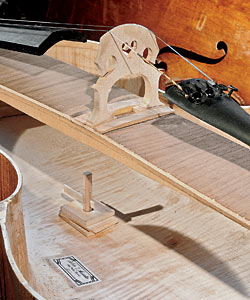
The modern violin emerged in northern Italy in the 1500s, in the cities of Brescia and Cremona. Brescia had the older school, but the Cremona guild perfected the instrument in the workshops of Amati, Guarneri, and Stradivari. Most notably, in the late 17th century, Antonio Stradivari combined Cremona’s sweetness of tone with the famous power of Brescia.
The Napoleonic Wars and their aftermath brought this violinmaking to a halt. Gradually, hundreds of Cremona instruments made their way into palaces and music halls around Europe and, later, the world. But something was lost in those interim decades—some say never to be recovered—and a consensus has emerged that the sound and baroque design of those early Italian violins has never been equaled.
Related:
STRING THEORY »
Cal Meineke's studies the science of violinmaking
“Consensus” is a murky term, however, when tradition, reputation, and cost all play a role. Radical redesigns of the violin’s familiar feminine-torso shape have occasionally popped up, but none of them caught on. While many of the world’s best solo performers insist on using vintage violins made by the Cremona luthiers, scores of top players around the world choose instruments made by modern masters, such as Michigan’s Joseph Curtin, Britain’s Roger Hargrave, or France’s Patrick Robin. The German musician Christian Tetzlaff plays a modern violin made by Stefan-Peter Greiner, preferring it to a Strad. Many of the best violinmakers today carefully copy the measurements of famous old Italian instruments— while using computers and other cutting-edge technology to help them refine the final sound quality.
Photograph: Julia Meineke


